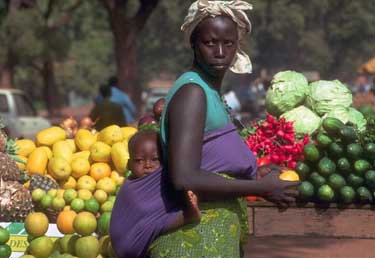Tiempo Climate Cyberlibrary
Gender and Climate Change - a Forgotten Issue?
 |
Ulrike Röhr discusses the historical lapse
in assimilating gender issues in the climate change
debate and the urgent need to undertake research and
analysis on this issue.
The author is director of genanet - focal point
gender, justice, sustainability, which aims to
integrate gender justice within environmental and
sustainability policies. Her primary areas of
responsibility are gender issues in energy and
climate change.
|
Until very recently, gender issues have not played a
major role in climate protection discussions. This is
surprising given the situation that equity in general,
especially between South and North, is regularly on the
agenda and is a key issue in the climate change
negotiations.
Only in the past couple of years have discussions about
gender during
Conference of the Parties meetings to the United Nations
Framework Convention on Climate Change (UNFCCC) been
raised. At the Ninth Conference of the Parties, held in
December 2003 in Milan, Italy, a network
of people interested in gender issues was established.
The network organized two workshops on gender and climate
change at the Tenth Conference of the Parties, held in
December 2004 in Buenos Aires, Argentina. Activities and
discussions on gender are already planned for the Eleventh
Conference of the Parties to be held in November and
December this year in Montreal, Canada.
Thus, at the international level of climate change
negotiations, gender issues are on the rise. Moreover, many
projects in developing countries are now addressing the
different situation of women and men respective to their
different vulnerabilities to climate change. In the
industrialized countries of the North, after an absence of
activities on gender and climate change, it would seem that
this issue is about to be discovered.
There are a number of activities already underway. A
research project at the Institute for
Social-Ecological Research in Germany is dealing with
gender
issues and emissions trading. City networks are
contributing to increase the share of women in decision
making in climate change policies. The
Climate Alliance of European Cities coordinated the
project Climate
for Change: Gender Equality and Climate Change Policy.
The
regional government of Lower Austria has considered
gender mainstreaming within their
climate change programme. All of these activities are
based on the premise that climate change policies will be
more effective if more women are involved and if gender
issues are addressed.
Against this background I want to look more closely at
how climate change is tangent to gender relations - and
vice versa.
Questions to be raised when dealing with climate change
from a gender perspective are:
- Are there gender differences in the perception of,
and the response to, climate change?
- Who is causing climate change, by which activities,
and for what purposes? How is the polluter-pays-principle
taken into account in mitigation and adaptation policies
and measures?
- Are there gender differences as to what policies and
measures are preferred and, if so, what are the reasons
for these differences?
- Are women and men affected differently by the effects
of climate change? What are the gender specific impacts
of climate change and its resulting environmental
damages?
- Are there gender differences in negotiations and
decisions on climate change policy? How and to what
extent are women participating when it comes to working
out and deciding about climate protection programmes and
measures? How do the results and programmes impact gender
relations, for example, climate policy guidelines and
directives at the national, the European Union and the
international level?
|

|
© Corel Corporation
|
Because there is an obvious historical lack of research,
many of these questions cannot be answered at present. And
not all these questions are similarly relevant in each
region of the world. In the climate debate, questions
linked to adaptation are more relevant in the South, while
in the North questions connected to mitigation are more on
top.
Gender and climate change in the South:
adaptation
It is widely acknowledged that the negative effects of
climate change are likely to hit the poorest people in the
poorest countries the hardest. In other words, the poor are
the most vulnerable to climate change.
Women form a disproportionate share of the poor. Seventy
per cent of human beings worldwide living below the poverty
line are women. In particular, in developing countries and
communities that are highly dependent on local natural
resources, women are likely to be disproportionately
vulnerable to the effects of climate change. Climate change
often impacts the areas that are the basis of livelihoods
for which women are responsible, for example, nutrition and
water and energy supplies. Moreover, because of gender
differences in property rights, access to information and
in cultural, social and economic roles, the effects of
climate change are likely to affect men and women
differently.
The effects of climate change on gender inequality are
not limited to immediate impacts and changing behaviours
but also lead to subsequent changes in gender relations.
Spending more time on traditional reproductive tasks
reinforces traditional work roles and works against a
change in which women might begin to play other roles.
For instance, because women are primary care-givers in
times of disaster and environmental stress, the occurrence
of magnified burdens of care-giving is likely to make them
less mobile. Also, since climate change is expected to
exacerbate existing shortfalls in water resources and
fuelwood, the time taken to fetch water or wood (which in
most countries is the responsibility of women) will
certainly increase women's workloads, thus, limiting
their opportunities to branch out into other,
non-traditional activities.
|
The network Gender in
Climate Change has given the following example of
the differential impact of a natural hazard on women
and men:
Following the
cyclone and flood of 1991 in Bangladesh the death
rate was almost five times as high for women as for
men. Warning information was transmitted by men to
men in public spaces, but rarely communicated to the
rest of the family and, as many women are not allowed
to leave the house without a male relative, they
perished waiting for their relatives to return home
and take them to a safe place. Moreover, as in many
other Asian countries, most Bengali women have never
learned to swim, which significantly reduces their
survival chances in the case of flooding. Another
clear illustration of the different vulnerabilities
women and men face is offered by the fact that more
men died than women during
Hurricane Mitch. It has been suggested that this
was due to existing gender norms in which ideas about
masculinity encouraged risky, 'heroic' action
in a disaster.
|
To be successful, adaptation policies and measures
within both developed and developing countries need to be
gender sensitive. To understand the implications of
adaptation measures for all people involved, it is
necessary that all members of an adapting community are
represented in climate change planning and governance
processes.
During a drought in the small islands of the Federal
States of Micronesia, the knowledge of island hydrology
from women as a result of their land-based work enabled
them to find potable water by digging a new well that
reached the freshwater lens. Women, however, are often
expected to contribute unpaid labour for soil and water
conservation efforts yet are absent from the planning and
governance processes. Equal involvement of men and women in
adaptation planning is important not only to ensure that
the measures developed are actually beneficial for all
those who are supposed to implement them, but also to
ensure that all relevant knowledge, (that is, knowledge
from men and women) is integrated into policy and
projects.
Gender and climate change in the North:
mitigation
The participation of women in decision making, in
planning and working out climate protection programmes is
as important in the North as in the South. In the project
Climate for
Change, the involvement of women has been investigated,
leading to the following results.
The relevant fields of action for climate protection
such as energy policy, urban mobility and urban planning,
are definitely male-dominated because of their technical
focus. Among others, two initial questions arise. Firstly,
who might profit if climate protection programmes lead to
job creation? And secondly, what is the effect on the
planning of measures and policies if they are almost
exclusively planned from the viewpoint of one gender, whose
background of experience usually excludes the work involved
in caring and providing for others? Such questions should
encourage us all to reflect on and discuss these important,
everyday issues.
Up to now, there have been only few studies that have
specifically addressed gender aspects in climate protection
in industrialized countries. But there is a certain amount
of data, especially from Germany, which points to
differences between the sexes, and leads to the assumption
that the priorities of women in climate protection may be
different from those of men. The data lead to the following
conclusions.
- Women and men perceive and assess risks differently,
and that is also true for climatic change. More than 50
per cent of the women, but only 41 per cent of the men,
classify climate change caused by global warming as
extremely or very dangerous. Consequently, women are more
strongly convinced than men that global warming is
unavoidable in the next 20 to 50 years.
- Trust placed in the role played by environmental
policy also varies according to gender. More women than
men are sceptical that Germany can cope with problems
resulting from climate change. Nonetheless, almost 62.9
per cent of the women, but only 53.8 per cent of the men,
are in favour of a pioneer role for Germany in climate
policy.
- These differing perceptions of climate change, and
the political possibilities of reacting to it, affect
each gender's motivation to protect the climate.
Women are more willing to alter environmentally harmful
behaviour. They do not rely as much on science and
technology to solve environmental problems to the
exclusion of lifestyle changes. As a result, they place a
higher value on the influence exerted by each and every
individual on preventing climate change.
- Studies show that women have a definite information
deficit on climate politics and climate protection. This
raises the question of how the subject matter is
communicated. Is it slanted toward technically interested
people? Do the selection of photographs and the layout
suggest that the target group is male? Browsing through
brochures and informational material, this often seems to
be the case. These discrepancies are particularly
noticeable with regard to the extent to which people are
informed about the international climate negotiations.
But despite their relative lack of knowledge, women seem
to be more prepared for behavioural changes than men, as
they recognize the urgency of the need for changes in
behaviour. In many areas they are already adjusting their
behaviour to meet this need, for example, by reducing
their energy consumption, using more public transport and
changing their nutrition and shopping habits.
- The instruments used to prevent climate change are
probably also gender-biased. For example, how are
economically differing preconditions taken into account
in the design of these instruments? In Europe, women
generally earn 28 per cent less than men, and 27 per cent
of single mothers live below the poverty line.
In general, all these gender-specific differences are
either due to physiological differences or, to a much
greater extent and scope, to differences in social roles
assigned to women and men and gender-specific identities in
society. Gender roles and identities are linked to gender
hierarchies in terms of opportunity and participation in
power structures in society. When considering the issue of
gender relations, one must, therefore, also always bear in
mind the power relations associated with them.
Looking at climate change mitigation from a gender
perspective we, last but by no means least, have to answer
these questions. Who, primarily, is causing the problems of
carbon dioxide emissions? Who gets the benefits? Why is the
polluter-pays principle so little taken into consideration
in climate change policies? There might well be a strong
connection between gender relations, power relations and
these questions that has not yet started to be
discussed.
|

|
© Corel Corporation
|
The outlook
As mentioned above, gender issues have not been
recognized in the UNFCCC negotiations until now, although
there was a very weak decision at the Seventh Conference of
the Parties in December 2001 in Marrakesh, Morocco
regarding the nomination of women in the bodies of the
UNFCCC.
To improve this situation, some fundamental requirements
have to be addressed immediately so as to provide a just
and equitable approach to this issue.
Research and data. We do not know enough about
gender aspects of climate change, particularly in the
North. For example, with regard to climate protection
measures, there is no gender analysis from a Northern
perspective, only, in some aspects, from a Southern
perspective. All climate protection measures and programmes
and all instruments for mitigating climate change or
adapting to climate change must be subject to a
gender-focused analysis. All climate change-related data,
scenarios, and so on, need to be disaggregated by gender.
Gender-disaggregated data are particularly lacking for the
developed world.
Relevant research needs to be developed and financed.
This requires gender experts and climate researchers to
engage in the issues, and it requires funders to support
such research projects. Based on existing knowledge in the
area of climate change as well as in other areas, specific
suggestions for research projects can easily be developed
and advocated.
Gender mainstreaming. Gender must be universally
integrated into climate protection negotiations and policy
making at national and international levels. The different
needs, opportunities and goals of women and men need to be
taken into account. The beginning
post-2012 process offers an important opportunity.
Participation. Women must be involved in climate
protection negotiations at all levels and in all decisions
on climate protection. Representation by numbers is not
enough. We need women represented and we need gender
experts involved.
Information/publications. There is a general
information deficit on climate protection and related
policies. New information materials and strategies need to
be developed. They need to include gender aspects, and they
need to be targeted to group specific, including being
tailored for women's information channels.
Monitoring. Gender mainstreaming of climate
change-related research, policy making and implementation
needs to be monitored at the national and international
levels. This can be summarized within three main goals.
- Closing knowledge gaps relating to gender aspects of
climate change in the developed world, for example,
through research and the collection of
gender-disaggregated data.
- Including more women and gender experts in climate
protection-related negotiations and decision making at
all levels.
- Integrating gender-related knowledge into policy
making, implementation, monitoring, and communication
strategies and materials.
The above-mentioned requirements are based on the paper
Gender and Climate Change in the North: Issues, Entry
Points and Strategies for the Post-2012 Process and
Beyond which was written by Minu Hemmati for
genanet - focal point gender justice and
sustainability.
If any climate protection policy ignores the
afore-mentioned as well as many other, proven or as yet
only suspected, gender aspects, it cannot be accepted as
sustainable, since it would have a counter-productive
effect on gender equality. Without taking gender aspects
into consideration, the task of preventing climate change
will be difficult to achieve.
I am absolutely certain that gender-just participation
and recognition of gender relations will lead to a more
comprehensive view of climate change. The full diversity of
social groups and their living situations are more likely
to be taken into account. Children, the elderly and
migrants, for example, will be taken into rightful account.
This will, in turn, lead to improvement of the measures,
and to a higher acceptance of gender issues amongst the
global populace.
Further information
Ulrike Röhr, genanet - focal point gender, justice,
sustainability, LIFE e.V., Hohenstaufenstr. 8, 60327
Frankfurt am Main, Germany. Fax: +49-69-740842. Email:
roehr@life-online.de.
Web: www.genanet.de.
On the Web
The Tiempo Climate Cyberlibrary provides a listing of
websites on
gender and climate change.


